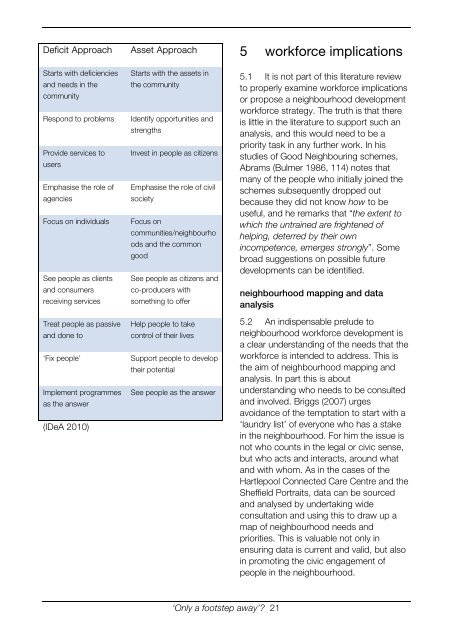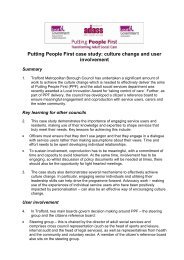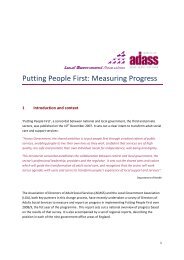'Only a footstep away' - Skills for Care - Think Local Act Personal
'Only a footstep away' - Skills for Care - Think Local Act Personal
'Only a footstep away' - Skills for Care - Think Local Act Personal
- No tags were found...
You also want an ePaper? Increase the reach of your titles
YUMPU automatically turns print PDFs into web optimized ePapers that Google loves.
Deficit ApproachStarts with deficienciesand needs in thecommunityRespond to problemsProvide services tousersEmphasise the role ofagenciesFocus on individualsSee people as clientsand consumersreceiving servicesTreat people as passiveand done to‘Fix people’Implement programmesas the answer(IDeA 2010)Asset ApproachStarts with the assets inthe communityIdentify opportunities andstrengthsInvest in people as citizensEmphasise the role of civilsocietyFocus oncommunities/neighbourhoods and the commongoodSee people as citizens andco-producers withsomething to offerHelp people to takecontrol of their livesSupport people to developtheir potentialSee people as the answer5 work<strong>for</strong>ce implications5.1 It is not part of this literature reviewto properly examine work<strong>for</strong>ce implicationsor propose a neighbourhood developmentwork<strong>for</strong>ce strategy. The truth is that thereis little in the literature to support such ananalysis, and this would need to be apriority task in any further work. In hisstudies of Good Neighbouring schemes,Abrams (Bulmer 1986, 114) notes thatmany of the people who initially joined theschemes subsequently dropped outbecause they did not know how to beuseful, and he remarks that “the extent towhich the untrained are frightened ofhelping, deterred by their ownincompetence, emerges strongly”. Somebroad suggestions on possible futuredevelopments can be identified.neighbourhood mapping and dataanalysis5.2 An indispensable prelude toneighbourhood work<strong>for</strong>ce development isa clear understanding of the needs that thework<strong>for</strong>ce is intended to address. This isthe aim of neighbourhood mapping andanalysis. In part this is aboutunderstanding who needs to be consultedand involved. Briggs (2007) urgesavoidance of the temptation to start with a‘laundry list’ of everyone who has a stakein the neighbourhood. For him the issue isnot who counts in the legal or civic sense,but who acts and interacts, around whatand with whom. As in the cases of theHartlepool Connected <strong>Care</strong> Centre and theSheffield Portraits, data can be sourcedand analysed by undertaking wideconsultation and using this to draw up amap of neighbourhood needs andpriorities. This is valuable not only inensuring data is current and valid, but alsoin promoting the civic engagement ofpeople in the neighbourhood.‘Only a <strong>footstep</strong> away’? 21
















